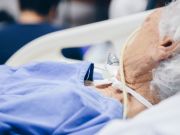Findings seen in series of 66 patients with COVID-19 respiratory failure receiving mechanical ventilation
TUESDAY, May 12, 2020 (HealthDay News) — Many critically ill patients with COVID-19 respiratory failure managed with mechanical ventilation and established acute respiratory distress syndrome (ARDS) protocols survive, according to a letter to the editor published online April 29 in the American Journal of Respiratory and Critical Care Medicine.
David R. Ziehr, M.D., from Massachusetts General Hospital in Boston, and colleagues present the respiratory pathophysiology of 66 adult patients with COVID-19 respiratory failure treated with invasive mechanical ventilation.
The researchers found that 85 percent of the patients met Berlin criteria for ARDS and most had mild-to-moderate ARDS. The median positive end-expiratory pressure (PEEP) was 10 cm H2O on intubation. The ratio of arterial oxygen partial pressure to fractional inspired oxygen was 150 in the 31 patients who underwent prone ventilation and compliance was 33 mL/cm H2O immediately before prone positioning and increased to 232 and 36 mL/cm H2O, respectively, after prone positioning. Patients underwent prone ventilation for a median of two sessions (median, 18 hours/session) over 72 hours. Concurrent neuromuscular blockade was received by 12 patients. Median PEEP was 13 and 14 cm H2O while supine and prone, respectively. Overall, 41 of the patients were successfully extubated, with a median of 16.0 days of mechanical ventilation. Tracheostomy was performed in 14 patients. A majority of the patients (50 patients; 75.8 percent) were discharged from the intensive care unit. There were 11 deaths (16.7 percent).
“We recommend that clinicians provide evidence-based ARDS treatments to patients with respiratory failure due to COVID-19 and await standardized clinical trials before contemplating novel therapies,” a coauthor said in a statement.
Several authors disclosed financial ties to the pharmaceutical industry.
Copyright © 2020 HealthDay. All rights reserved.








